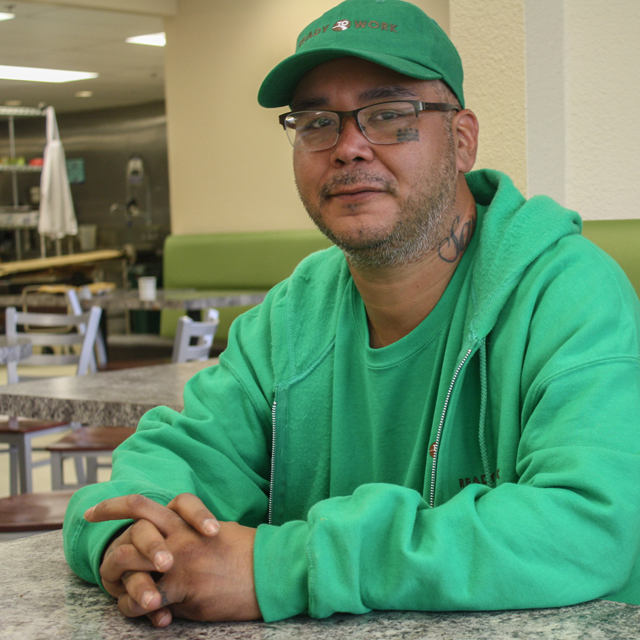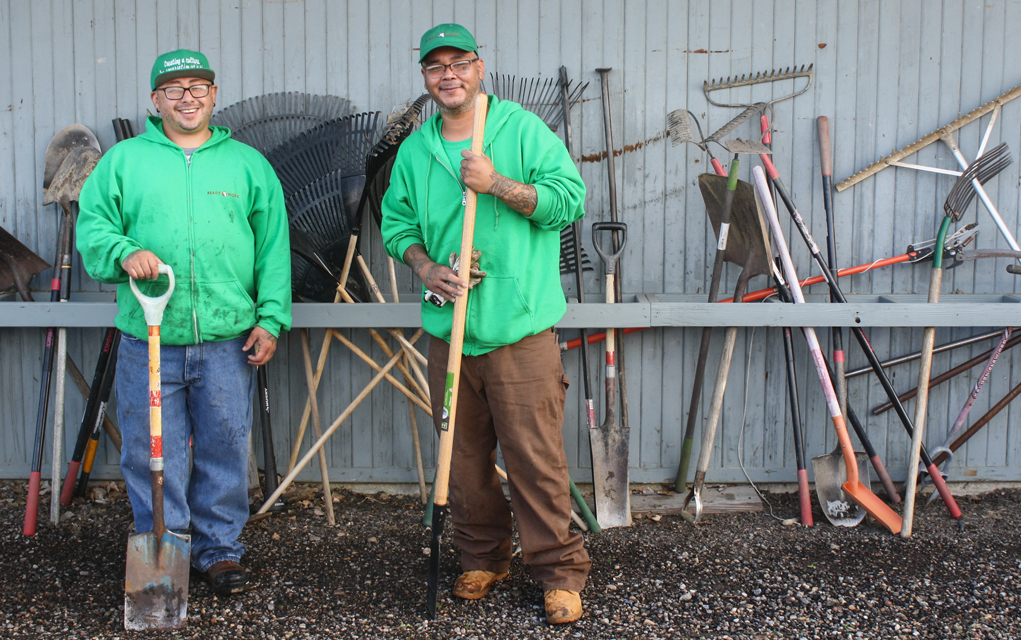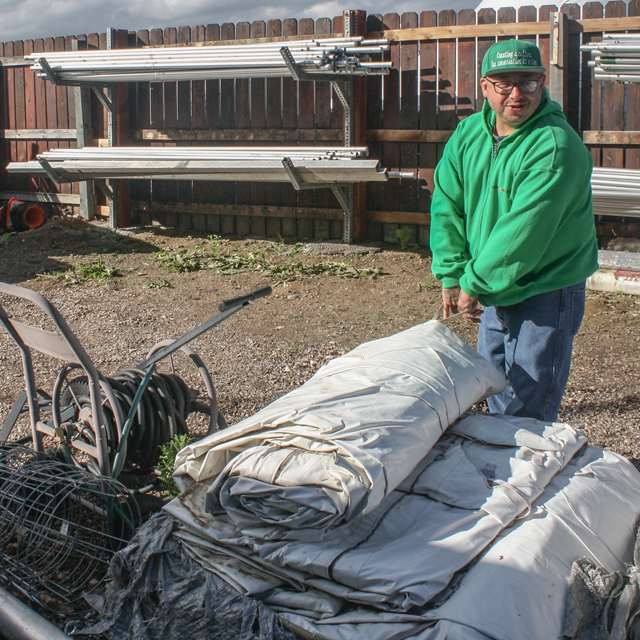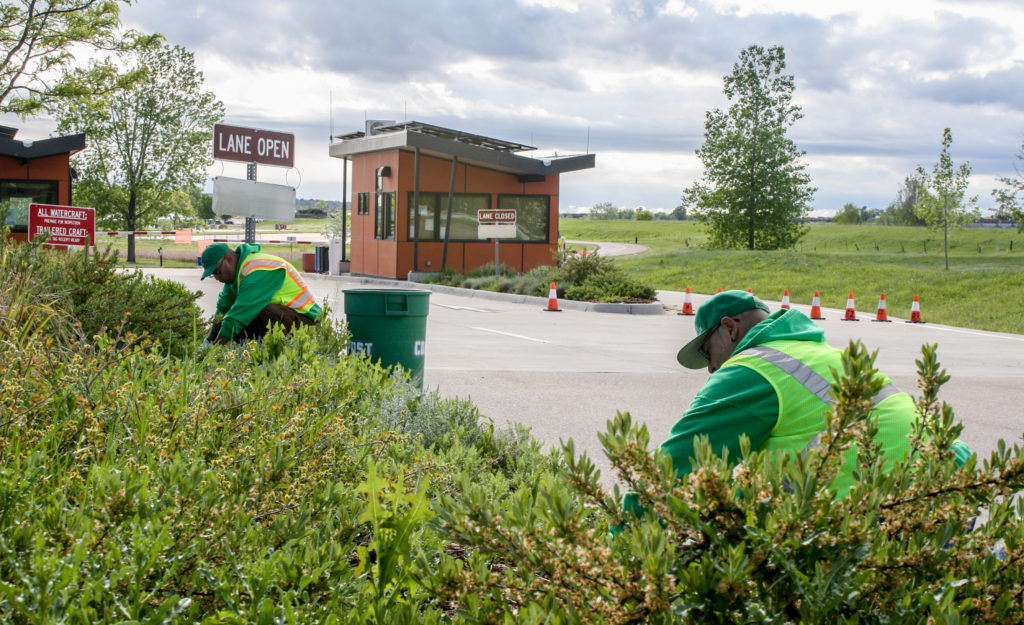
Jose Rodriguez can’t remember a time he’s been out of prison this long. “I’m actually pretty proud of that,” he says sitting in the cafeteria of Boulder Bridge House’s Ready to Work building. Released almost a year ago from the Colorado Territorial Correctional Facility in Cañon City, Rodriguez, now 35, has been in and out of correctional facilities since he became involved with gangs at a young age.
“They usually gave you $100 and sent you on your way,” he says about other times he’s been released. But this time it was different.
Prior to his release last year, Rodriguez was signed up for Health First Colorado, the state Medicaid program, and connected to Ready to Work, a residential and employment training program that also helps facilitate medical care.
Back in 2003, while incarcerated in Arizona, Rodriguez was diagnosed with diabetes and encouraged to work out and take daily medications, advice he rarely followed during brief periods he spent outside prison without insurance.
This time, however, he left the correctional facility, Medicaid card in hand, his daily medications covered by the government insurance program. He’s also been able to get dental treatment and attend one-on-one therapy for the first time, coordinated through Ready to Work.
“This program that I’m in, with the support they give me and just being able to have Medicaid and stuff like that, I consider all my bases covered,” Rodriguez says. “I finally have a chance to be successful in life and it feels great. It’s something new to me.”
Rodriguez was enrolled in Medicaid as part of a statewide effort by the Department of Corrections (DOC) and the Department of Health Care Policy and Financing (HCPF) which administers Colorado’s Medicaid program. In March 2018, the two agencies entered into a data sharing agreement to connect people in correctional facilities to health care services in the community in order to avoid any lapses in care upon their release.

There are more than 120,000 people in the criminal justice system in Colorado, about 20,000 of whom are in state prisons. Although federal law prohibits Medicaid dollars from covering health care costs while people are incarcerated, a large percentage of the population is eligible for the program as soon as they are released. In 2014, Colorado took advantage of a specific provision of the Affordable Care Act and opened up the government insurance program to low-income individuals without dependents in an effort to decrease the statewide uninsured rate. According to Laurel Karabatsos, interim Medicaid director at HCPF, that means about 70-75 percent of all releases from DOC are Medicaid eligible.
“This is a needy population,” Karabatsos says. “People are coming back out right into the community, and there are many things we need to ensure are in place so that their condition isn’t exacerbated [by problems] and we have more expensive costs or they end up back in those institutions.”
According to research published in the New England Journal of Medicine in 2007, the risk of death for former inmates is 3.5 times that of the average person. Within the first two weeks after release, that risk rises to 12.7 times the average. The leading cause of death for this population, the research shows, is drug overdose, followed by cardiovascular disease, homicide and suicide.
Furthermore, almost half of the U.S. prison population has some sort of mental health need, including substance abuse disorders, all of which can complicate how successful someone is as they re-enter the community.
“If you didn’t have a chronic health condition before you went into prison, you’re probably going to have at least PTSD, and some sort of hypertension or high blood pressure just from being incarcerated,” says Terri Hurst, policy coordinator at the Colorado Criminal Justice Reform Coalition (CCJRC), a nonprofit, nonpartisan advocacy group. “It’s a stressful place to be, and add to that any sort of underlying trauma, or behavioral health issues, and… people leave not very healthy.”
Under the data sharing agreement, each month DOC gives HCPF a list of inmates expected to be released in the next six months. HCPF then shares that information with its regional care organizations, which in turn reach out to people both pre- and post-release in order to help coordinate their health care on the outside.
“That critical time right after release you have to get them surrounded by the supports that they need, to prevent any sort of recidivism or anything like that,” says Colleen Daywalt, spokesperson for Colorado Community Health Alliance (CCHA), the regional coordinated care organization that covers Boulder County for HCPF.
“It’s helped us identify who needs our help the most,” Daywalt continues. “A lot of folks, when they’re being released, they are just inundated with having to figure things out. And so if we can do anything to smooth that process for them and to help them understand where they can find a provider, what their benefits are and how do you utilize them, that’s great.”
Hurst from CCJRC says she hasn’t heard of any other state that has taken on such an effort, although large counties around the country like Los Angeles, Clark County in Illinois and Maricopa County in Arizona have done so. In that way, Colorado’s effort is unique.
“We see it as a game changer for this population because the vast majority of the people involved in the justice system have never had access to health insurance before,” Hurst says. “It’s not perfect, but the progress I’ve seen in the past five years is something to applaud. The state agencies have stepped up and are working together.”
• • • •
On Aug. 31, 2016, Steve Maes was released from prison after 23 years. A native of Denver, Maes pretty much went from juvenile detention straight into DOC, with little break in between. He had never had a steady job or lived on his own, let alone had health insurance. But with the help of DOC, Maes was enrolled in Medicaid before he was released.
“It was all done for me when I came out,” he says. “I wasn’t on meds or nothing, but I had glasses, [needed] dental care and had to go to the doctor. I got real sick when I came out. My immune system was weak.”
He also experienced anxiety, as he struggled to adjust to a different lifestyle at Ready to Work and interact with people from completely different backgrounds and life experiences. “I had issues when I came out, adjustment was hard for me,” he says.

More than two years later, however, Maes is living on his own and is no longer on Medicaid. The difference has been significant for Maes, who recently got so sick he had to visit the emergency room, only part of which was paid for by private insurance.
Having worked in other landscaping jobs, he’s back at Ready to Work as a supervisor, helping others go through the readjustment process.
“I tell all the guys coming out, ‘Take advantage of everything while you’re on Medicaid because when you’re done you’ll have to pay for it,’” he says.
Since the expansion of Medicaid in 2014, DOC has worked on getting inmates signed up so they have access to its benefits upon release by bringing in nurses to walk people through the eligibility and application process. But most people were never signed up for Medicaid benefits before their incarceration, and DOC is still completing a large number of applications for first-time users, according to Kellie Wasko, deputy executive director at DOC. Still, about 98 percent of people eligible for Medicaid leave correctional facilities already enrolled, according to Wasko.
If for some reason people haven’t been signed up before leaving a facility, DOC trains parole offices to help educate people about how to enroll, where to access care and other ways to utilize their Medicaid benefits. Additionally, inmates who spend longer than 24 hours in inpatient care at a hospital can use Medicaid benefits, resulting in even more enrollment. Since 2018, once someone is signed up, even if they go back into a facility, their benefits are only suspended, not terminated, making access to care once they are released that much easier.
“People can argue the pros and cons on the Obamacare, the Affordable Care Act, but I think the single biggest thing that we’ve noticed is that these single adults without children now have access to Medicaid,” says Widd Medford, program director for the Ready to Work program out of Bridge House. “That expansion has significantly helped our guys access medical care and dental care.”
Mental health care and substance abuse treatment covered by Medicaid have also played a significant role in the success of former inmates, Medford says. “Almost all of our guys that have come from DOC have had some substance use disorder that was really driving the criminal behavior,” he says.
It’s one thing to be enrolled in Medicaid, but quite another to understand the benefits and actually access care, especially for people who aren’t released into programs like Ready to Work.
As part of their data sharing agreement and in an effort to address this issue, DOC also gave HCPF historic data of releases from 2014-17 so that the agency could establish some baseline metrics and a strategy moving forward. By looking at how people were using Medicaid benefits upon release, the reasons why they were using them and how long it took them to access care after release, the agency hopes to gain a better understanding of how to best help those coming out of prison to successfully re-enter the community while preventing high mortality rates within that population. The data can also help create better systems of interaction with Medicaid members and help them access care more efficiently.
By analyzing the data, HCPF determined that about 40 percent of people with Medicaid released from DOC accessed some sort of physical health care within the first two months following re-entry, the largest portion of this access coming through emergency rooms. Only 15 percent, however, sought mental health care despite the growing need for these services, especially for substance abuse disorders. (In part, this is due to people using the DOC’s own behavioral health provider network that is separate from Medicaid, and therefore not captured in the data.) Moreover, the mortality rates collected by HCPF show that death rates for released prisoners actually increased after two months, demonstrating that establishing a stable, longer connection to medical providers is proving to be a bit more challenging than scheduling initial visits.

While there are limitations to this data, coupled with the list of soon-to-be-released inmates, HCPF is using it with the goal of establishing health care for the long-term for this population.
Medford, who has worked with newly released prisoners for years, first through public health departments prior to his position at Bridge House, says the efforts by DOC and HCPF have really made a difference for the people he sees coming out of prison.
“It’s definitely different than what it used to be,” says Medford, who gets anywhere between six and 10 letters a week from inmates who will soon be released and are interested in the program. “For me to be able to go back and look and say 100 percent of our parolees in the last year and a half have come out with their Medicaid active, that’s a pretty big change.”
The Ready to Work program at Boulder Bridge House gets about 15 parolees each year, people like Rodriguez and Maes coming out of DOC and readjusting to life on the outside.
Medicaid benefits are particularly important to the success of alcoholics and opioid abusers because the program pays for the Vivitrol shots that block the receptors that allow a person to feel the effects of the given substance. Without Medicaid, many who receive Vivitrol while incarcerated would not be able to continue its use on the outside. But with Medicaid benefits, they can be given the shot within a week or two of arriving at a place like Bridge House.
“Medicaid is allowing these providers to try innovative ways of providing services on site,” Medford says. “Our guys don’t have to get on the bus, go somewhere, or set up an appointment for three weeks out, four weeks out. They can just get it done immediately. It’s quick access to care, mainly because the Medicaid turned on before they were released.”
Key to all this, according to Wasko from DOC, are the medical codes that are shared as part of the list of upcoming releases, codes which indicate a person’s level of physical or mental health risk. By sharing this information with HCPF, the regional organizations and community partners, like Bridge House, “We’re able to identify early on when offenders are going to need extended care once they get out,” Wasko says. “So it’s that continuity piece where they’re getting the same type of care that they got internally as what they are getting out on the street.”
Not everyone is released into programs like Ready to Work, however, and HCPF shares the same list of inmates to be released and their medical conditions with regional organizations like CCHA. In turn, CCHA has been able to connect Medicaid members to specific care coordinators, either nurses or social workers, who in turn help people schedule initial doctor visits, ensure prescriptions are refilled, and connect with mental health and substance abuse services, as well as schedule transportation to appointments, all of which is covered by Medicaid.
Still, trust can often be a big hurdle in connecting people to care, according to Daywalt with CCHA. But by coordinating with both the community-based organizations and DOC, CCHA is working on building relationships at the facilities and with recent releases.
“One of the things that we found helpful is having the social workers or the care managers that they’re working with while they’re in a facility refer to us or recommend us so that that individual knows that we’re not just some random organization,” Daywalt says. “That we are there to support them, that we have street cred, if you will.”
Once people are connected, however, care coordinators at CCHA stick with people for as long as needed, and sometimes these relationships last years as people readjust and establish themselves post release. “It really goes beyond just getting their immediate physical and behavioral health needs met. Then we start looking at, OK, housing, transportation, food, jobs — what else do you need to be to be successful?” Daywalt says.
As a product of the data sharing agreement between DOC and HCPF, CCHA is also working to connect with people, especially those with extensive medical needs, prior to their release from correctional facilities through video conferencing at three different state prisons. Currently, about four people attend the monthly video calls.
“Sometimes they’re harder to track down after they’re released,” Daywalt says. “So that’s our opportunity to get in and say, ‘Here are your benefits, here’s the services we can provide. Here’s how we can help you.’”
Connecting Medicaid-eligible inmates with care coordinators prior to their releases isn’t actually a billable service for HCPF, but the benefits are worth it, according to Karabatsos, and the agency actually incentivizes the regional organizations to pay attention to this population in their contracts.
“It is in their best interest because once that member is released,” she says, “they can help ensure continuity of care and keep costs down, avoid future hospitalizations, readmissions, that kind of thing.”

• • • •
Almost a year after his release, Rodriguez still has some dental work that needs to be done, but he’s been working out more and taking his diabetes medications consistently, trying to focus on staying healthy. Plus, he’s kept doing one-on-one counseling, covered by Medicaid.
“I never thought I was that person who needed therapy but it really helps,” he says. “When you’re used to that lifestyle it’s frightening to be out here by yourself to some extent.”
That’s not to say the statewide effort isn’t without its challenges. Both Daywalt and Hurst admit that access to care is still an issue, especially when it comes to specialists and mental health providers. In booklets CCJRC provides to all of the state facilities, the organization encourages people to be patient with their medical care after release, especially with mental health services, as it may still take weeks to see a psychiatrist.
“It’s just getting the access to care piece down and making sure there are providers that aren’t going to stigmatize people if they find out they’re justice involved,” Hurst says. Providers, “that are welcoming, and that actually have availability and there’s not a wait list.”
Additionally, the data sharing agreement doesn’t cover any of the state’s 56 county jails or other municipal jails, which hold about 12,000 people on average. Although there is some coordination between HCPF and these facilities, it varies from county to county.
“Jails are probably the harder piece to get our arms around because each one has their different processes and we don’t have a centralized data collection system,” Hurst says.
Plus, these programs are still new, and Daywalt says it’s too soon to measure how effective these efforts have been to date.
“It’s still early to say how well it’s working. Tracking that individual and that individual’s outcomes, what happens long-term, six, nine, 12 months from now…” Daywalt says. “It will be interesting to see a year from now what kind of progress we’re making and how many people are impacted.”
For the most part, however, it appears that the efforts by DOC and HCPF have resulted in more people enrolling in Medicaid and accessing care, and everyone — from the agencies themselves to community organizations and advocates are encouraged — by the progress. In many ways, this is as much about criminal justice reform as it is health care reform.
“The ability to provide offenders with any benefit structure upon discharging from the Department of Corrections is definitely a reform in ensuring continuity of care for successful re-entry,” Wasko from DOC says.
As Rodriguez puts it: “If they hadn’t [enrolled me in Medicaid], I don’t think I would have taken up the initiative to do it myself. They get you to set up with the right people.”
Having almost completed the program at Bridge House, Rodriguez is getting ready to transition to independent living soon. After working at IHOP for a brief period, he’s now a supervisor with Ready to Work, managing crews who help maintain open space areas and landscaping at the Boulder Reservoir. It reminds him of his childhood, helping his dad with a landscaping business and working in the agricultural fields.
“The way I see it, is I’ve spent a lot of my life destroying the community,” Rodriguez says. “And now it’s time to help fix that.”
It’s all in an effort to reunite with his three kids, who currently live down in Pueblo, something he hopes to do soon.
“I’m done,” he says about his previous lifestyle. “Going back is really not a concern to me. I want to stay in this lane.”














